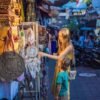Prior to the Balinese conquest of Lombok, the island was divided into a number of frequently warring Sasak princedoms. These Hinduized Sasak states converted to Islam in the sixteenth century, but they retained a syncretized religion that had some indigenous ancestor worship, Hindu elements, and newer Muslim beliefs and practices.
Conflicts between and within these princedoms was common at the time. Such divisiveness enabled the Balinese to conquer Lombok and to become the ruling caste, reducing the Sasak to vassaldom. The Balinese rulers instituted a number of techniques to reinforce their position, including language etiquette relating to caste, in which they spoke down to the Sasak, who were required to use the superior language level in speaking back to them; marriage levels, in which the Balinese could marry Sasak women, but Sasak men could not marry Balinese women; and corvée, in which Balinese could command Sasak labor.
The Balinese collected tribute in rice and confiscated Sasak land. Several unsuccessful Sasak revolts against the Balinese were attempted. The Dutch, interested in greater economic control, landed in Lombok in 1894, proclaiming themselves liberators of the Sasak from their Balinese oppressors. The Balinese and their Sasak supporters’ engagement in another conflict aided the Dutch conquest in 1895, leading to the puputan, or ritual suicide, of the Balinese ruling dynasty after their defeat.
The Dutch colonial government dissolved the ties of allegiance to earlier rulers by setting up a new administrative system under the rule of a resident in Bali, and the Dutch obtained major revenues from the agrarian sector.
During this period the division of the Sasak population into traditional Wetu Telu and the more orthodox Muslim Waktu Lima was pronounced.
Dutch-appointed Sasak administrators were usually Waktu Lima, and this provoked Wetu Telu discontent, sometimes taking the form of messianic and revivalistic movements during the early twentieth century. The Waktu Lima Sasak villages were most numerous along the main roads and in market centers, while Wetu Telu villages tended to be more self-sufficient and isolated. Political and economic centers were Waktu Lima, with Waktu Lima officials whose beliefs and practices conflicted with Wetu Telu customs. There was increasing Muslim proselytizing by Waktu Lima missionaries.
In the increasing conflict between the two Sasak groups many villages that had been previously considered Waktu Lima became designated as Wetu Telu, particularly in eastern Lombok. Although not predominant in the population, the syncretistic Wetu Telu, united by personal and kinship ties and economic redistribution, were found in the more isolated Sasak villages. In the early 1970s the Wetu Telu disappeared as a culturally distinct category. In 1942 the Japanese invaded Indonesia, ousting the Dutch. The Sasak remember this as a time of forced labor, poverty, and oppression.
After Indonesian independence, missionary Muslim leaders called “Tuan Guru” gained great political and economic power on Lombok, ensuring Waktu Lima dominance. The president stressed economic self-sufficiency and mutual aid. Economic conditions were deteriorating. The Land Reform Program of 1960 proved problematic, and attempts to implement it ended by 1965.
In 1965 an attempted coup, crushed by the military and blamed on the Communists, led to a bloodbath of alleged Communist sympathizers and a concomitant swelling of the ranks of the followers of the Tuan Guru as the Sasak attempted to avoid persecution. In the late 1970s BIMAS, or the “Green Revolution,” had a major economic impact on Lombok.
The most recent changes have been an upsurge of economic development projects and tourism.



